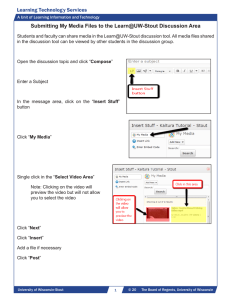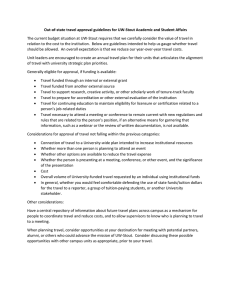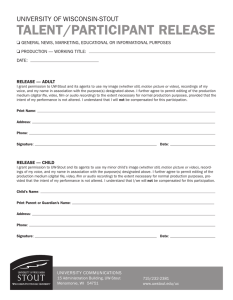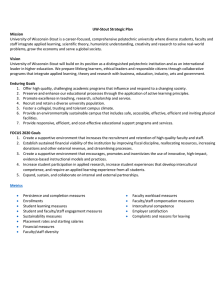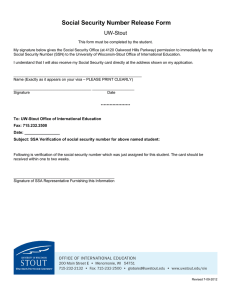1 Perceptions of the Culture, Productivity, and Dissemination of Research
advertisement
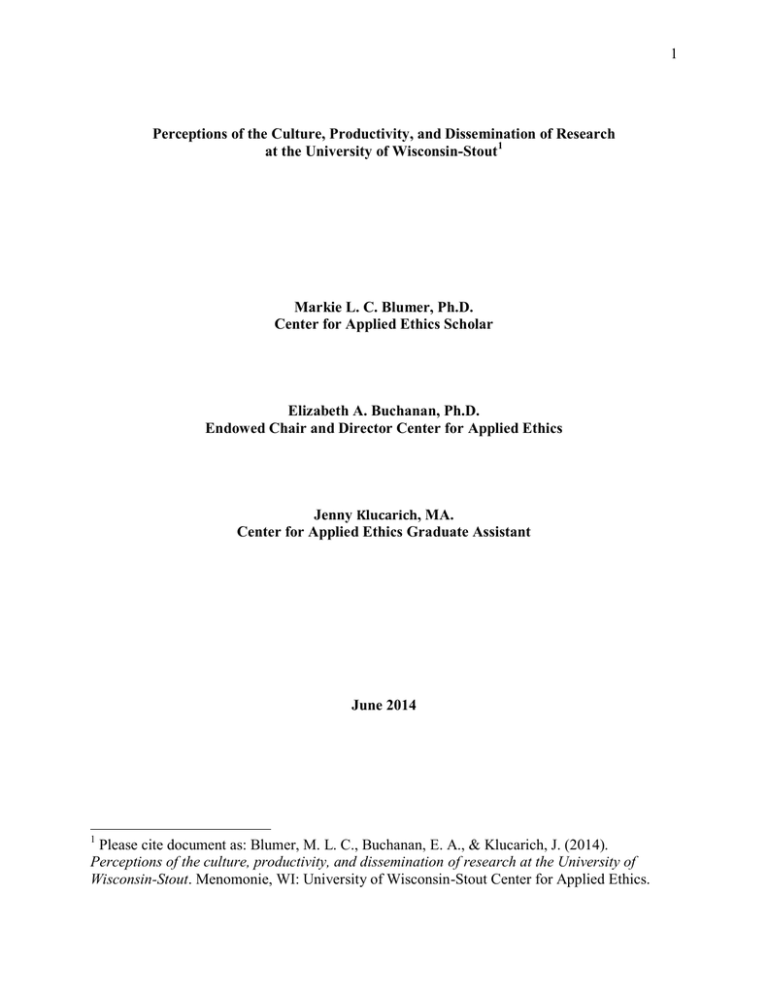
1 Perceptions of the Culture, Productivity, and Dissemination of Research at the University of Wisconsin-Stout1 Markie L. C. Blumer, Ph.D. Center for Applied Ethics Scholar Elizabeth A. Buchanan, Ph.D. Endowed Chair and Director Center for Applied Ethics Jenny Klucarich, MA. Center for Applied Ethics Graduate Assistant June 2014 1 Please cite document as: Blumer, M. L. C., Buchanan, E. A., & Klucarich, J. (2014). Perceptions of the culture, productivity, and dissemination of research at the University of Wisconsin-Stout. Menomonie, WI: University of Wisconsin-Stout Center for Applied Ethics. 2 Background The genesis of this study was faculty initiated and emerged from the University of WisconsinStout (UW-Stout) Engagement Sessions on Opening day of the Fall 2013 semester, which focused upon the idea of the university as an “emerging research institute”. The principle investigator, particularly as a new faculty member, became curious about the existent research culture and integrity practices in the context of the university being identified as an emerging research institute, and how the overall research culture may change (or remain unchanged) via this change in institutional classification. More specifically, the principle investigator was interested in the research culture and expectations at this university, as over the last two decades there has been more focus on the conducting of research, and a push towards obtaining external funding and dissemination of research across almost all institutional types (Blackburn, Bieber, Lawrence, & Trautvetter, 1991; Prince, Felder, & Brent, 2007). This classification change seemed to be, at least in part, a reflection of such changes. In addition, it has become the case that junior faculty are now expected to obtain tenure not merely on good to excellent instructional ratings, but also on their scholarly record (Blackburn et al., 1991; Prince et al., 2007). Thus, more information regarding the research expectations are helpful for faculty in this ever-growing research-intensive university environment. To the investigators’ knowledge, this is the first study of its kind at this university. This study was made possible through grant-funding via the UW-Stout Center for Applied Ethics. Institutional Review Board approval was obtained in February of 2014 based upon its status as exempt. The survey study took place between March and April of 2014. Participation in this survey study was voluntary. The survey instrument was housed via Qualtrics and was disseminated to UW-Stout populations via weblink to university email addresses from the investigators. Participants agreed to informed consent before starting the survey. They were given the option to not answer any query or to exit the survey at any time. Individuals are not being identified in the reporting and only group data is being reported (e.g., the analysis includes only aggregate data of any numbers in categories where there are less than 10 participants). All data attained has been de-identified to the highest degree possible. Survey items were of both a quantitative (75 items) and qualitative (10 items) nature making this a mixed data survey study (Blumer, Hertlein, & Haider, 2013, in review; Gambrel & Butler, 2013). Queries included on the instrument were based upon relevant scholarly literature (Blumer, Green, Murphy, & Palmanteer, 2007; Mumford et al., 2007; Thrush et al., 2007). This survey study was also vetted by academic staff, administrators, students, and faculty in the Research Services Office, the Center for Applied Ethics, and the Office of Planning, Assessment, Research and Quality prior to dissemination. The survey was composed of the following sections: sample demographics, research culture, research productivity, research collaboration, research dissemination, and research integrity. Being reported in this summary is information from the following sections: research culture, research productivity and research dissemination. 3 Sample Demographics Overview The researchers asked about sample demographics at the end of the survey. Data was collected for myriad demographics. Reported here is information regarding position in the university, division affiliation, length of time at the university, racial/ethnic background, sexual orientation, gender identity, and age. Data was collected and is being reported for the campus community as a whole (e.g., faculty, staff, administrators, students). This was an intentional decision by the investigators in hopes of fairly representing the campus research culture as a whole, and also in the context of the institute being a polytechnic university where not only faculty, staff, and administrator feedback is highly valued, but student feedback is as well. This is contrary to most of the previous research regarding the study of research culture and integrity practices in university settings, as typically information is gathered and/or reported from only students or faculty/staff/administrators within the university, and not all of these groups in totality. Findings 1,002 surveys were 2returned representing the following: 9.4% response rate3. Responses for UW-Stout by position were faculty/staff (40%), and students (60%) Responses by UW-Stout division affiliation were 27% College of Education, Health, & Human Sciences, 25% College of Science, Technology, Engineering, and Mathematics, 16% College of Arts, Humanities, and Social Sciences, 11% College of Management, 8% Administrative and Student Life Services, 6% Graduate School, 5% Academic and Student Affairs, 3% Chancellor’s Division Range of years at UW-Stout ranged from 6 weeks-40 years with a mean amount of time of 7.4 years 11% People of Color4; 89% European American or White 12% of people identified as having an alternate sexual orientation (meaning gay, lesbian, bisexual, questioning, or another self-identified orientation), 88% of people identified as having a heterosexual sexual orientation 61% identified as women, 37% as men, 1% as having an alternate gender identity (meaning intersex, transgender, or another self-identified identity) Range of ages was 19-66 years of age with a mean age of 37.49 years 2 Response rate does not sum to 100% for multiple questions, because there were questions where: 1) responses were dependent on previous response, 2) multiple responses were allowed, 3) only students responded, 4) only faculty responded, and 5) an answer was not ipsative. In cases where the sum does not total 100% one of these reasons will be articulated. Throughout the demographic data collection, responses were not ipsative so the responses ranged from the total number of respondents to roughly 600 responses. 3 Caution is suggested in generalizing results with significantly lower response rates. In general, the results provided here reflect participant’s beliefs and concerns with regard to the research culture. 4 While recognizing the vastly different experiences of people of various racial identities (e.g., Hispanic American versus African-American or Native American versus Asian-American), and those experiences within these identity categories (e.g. Hmong versus Chinese), it was necessary to collapse some of these categories to conduct the analyses due to the small numbers of respondents in each of the individual categories. 4 Summary The researchers believe the demographic sample is representative of the larger UW-Stout community. First, the demographics are comparable to those reported by UW-Stout for the Fall 2013 enrollment numbers, which included the following: student enrollment totaled 9,286, employment enrollment totaled 1,402 employees, 12% persons of color and 88% White or Caucasian, gender representation ranged from 30% male- and 70% female-identifying amongst graduate students and 50% male- and 50% female-identifying amongst the university as a whole. The sample demographics attained in the current study are also similar to those reported in the 2011 Campus Climate Index Study results in which the following were reported: 9% people of color and 88% White, 8% non-heterosexual and 92% heterosexual, 58% female- identifying and 41% male- identifying and <1% transgender-identifying (Kwaterski, Burton, & Mans, 2011). Finally, our number of respondents ranged from 1,002 at its highest to 104 at its lowest, which means that statistically speaking our confidence in our findings ranges from a 95% confidence interval with less than a 3% sampling error to a 95% confidence interval with less than a 10% sampling error (Sullivan, 2001). Perceptions of Campus Research Culture Overview The first part of the survey study explored the research culture of the university. The research culture was explored via queries in the following areas: definition of research of the university as an emerging research institute, research endeavors of the university as a polytechnic institute, experience in the role of researcher by campus members, benefits and drawbacks to engaging in research as a researcher, ways the university can support and reward research activity, and the degree to which faculty are able to balance teaching, research, and service. Definitions and endeavors of research During the 2013-2014 academic year a university-based committee was formed to explore the university as situated as an “emerging” or “applied research institute.” Members of this committee were from a variety of colleges and disciplines across the campus. One of the tasks charged to this committee was to define what it means for UW-Stout to be an “emerging research institute.” Toward this end, the definition of research at this university5 that was agreed upon was the following, “The original, uniquely human endeavors that contribute intellectually or creatively to a discipline.” This definition was included in the survey to determine its fit with the perceived research culture of UW-Stout. Participants6 were given the definition and asked if this definition of research conceptually aligns with their own. In answering this question, 91% (n = 907) reported “yes” and 9% (n = 90) reported “no” [see Figure 1. Alignment with proposed definition of research at UW-Stout]. 5 Source: Emerging Research Committee: Bomar, C., Lume, C. M., Wynn, S., Fanta, F., Brey, E., Budd, D., Neidmyer, G., Surdick, R., Lui, J., Gundala, R., Blumer, M. L. C., & Nold, S. (2014). Linking scholarly activities and the mission of a polytechnic university: UW-Stout as an emerging research institute. Menomonie, WI: University of Wisconsin-Stout. 6 Participation was not ipsative. 5 Yes No Fig 1. Alignment with proposed definition of research at UW-Stout The committee7 was also tasked with articulating the research endeavors of UW-Stout in the context of being a polytechnic. Toward this end, the committee stated that “…as a polytechnic institution it is important that research endeavors at UW-Stout include: a. b. c. d. e. Broad dissemination Student involvement Faculty, staff, student, and/or administrator participation A focus on addressing societal and/or community needs Support from the institution” These endeavors were provided to participants to assess their fitness as part of the perceived research culture of UW-Stout. Participants8 were given all of the forestated research endeavors, as well as an “other” category, and asked to select all that apply. The responses of participants from most to least frequent to this question, “…as a polytechnic institution, it is important that research endeavors include…” were the following: 82% (n = 821 responses) faculty, staff, student, and/or administrator participation, 80% (n = 796 responses) student involvement, 78% (n = 781 responses) support from the institution, 66% (n = 656 responses) a focus on addressing societal and/or community needs, 50% (n = 500 responses) broad dissemination, and 7% (n = 74 responses) other [see Figure 2. Research endeavors important at UW-Stout as a polytechnic institute]. 7 Source: Emerging Research Committee: Bomar, C., Lume, C. M., Wynn, S., Fanta, F., Brey, E., Budd, D., Neidmyer, G., Surdick, R., Lui, J., Gundala, R., Blumer, M. L. C., & Nold, S. (2014). Linking scholarly activities and the mission of a polytechnic university: UW-Stout as an emerging research institute. Menomonie, WI: University of Wisconsin-Stout. 8 Participation was dependent on previous response, multiple responses were allowed, and participation was not ipsative. 6 Broad Dissemination Student Involvement Faculty, Staff, Student, and/or Administrator Participation A Focus on Addressing Societal and/or Community Needs Support from the Institution Other Fig 2. Research endeavors important at UW-Stout as polytechnic institute Experience as a researcher Another part of exploring the research culture of the campus was inquiring about participation in research. Most respondents9 indicated that they had not participated in research in the role of researcher at this university (62%, n = 623). A little more than half (50.5%, n = 506) reported that they would have interest in participating in research in the role of researcher at this university in the future, with a number fewer than half (49.5%, n = 496) reporting that they would not have interest in participating in research in the role of researcher. Benefits and drawbacks of participating in research as a researcher Those participants10 who had experience as a researcher were given the opportunity to respond to questions regarding the benefits and drawbacks of research. The responses of participants from most to least frequent to the question, “What do you believe are some of the benefits to engaging in research activity…” were as follows: 81% (n = 520 responses) advances one’s field of study, 79% (n = 512 responses) encourages critical thinking in oneself and one’s students, 78% (n = 505 responses) opportunity for scholarly collaboration and networking, 74% (n = 479 responses) professional responsibility, 70% (n = 449 responses) makes a contribution to the community or has more global implications, 62% (n = 401 responses) enhance one’s teaching style and content, 48% (n = 312 responses) helps secure future grant-funding, 43% (n = 277 responses) essential in the promotion and/or tenure processes, 24% (n = 154 responses) promotes competition, and 5% (n = 34 responses) other. The responses of participants from most to least frequent to the query, “What do you believe are some of the drawbacks to engaging in research activity”…were the following: 36% (n = 203 responses) requires additional training, knowledge, skills, and/or experience, 31% (n = 178 responses) dislike of conducting research, 31% (n = 178 responses) lack of support from university, 25% (n = 144 responses) promotes competition, 20% (n = 115) distracts from one’s teaching style and content, 20% (n = 117) other, 17% (n = 95 responses) lack of support from college/division, and 15% (n = 86 responses) lack of support from department. 9 Participation was not ipsative. Participation was dependent on previous response, multiple responses were allowed, and participation was not ipsative. 10 7 University reward and support for research activity Those participants11 who had experience as a researcher were given the opportunity to respond to a query regarding the ways in which they believe the university can best support or reward engagement in research activity. Their responses from most to least frequent were as follows: 64% (n = 407 responses) offer more resources for research (e.g., equipment, staff, graduate assistantships, etc.), 57% (n = 360 responses) promote a culture of research, 52% (n = 331 responses) release time, 49% (n = 307 responses) merit pay (e.g., bonuses distributed to faculty/academic staff who exceed scholarly expectations), 42% (n = 263 responses) dissemination of more scholarly awards and recognition, 42% (n = 264 responses) provide more information to faculty/academic staff on funding opportunities that focus on higher dollar awardings, 36% (n = 228 responses) encourage scholars to disseminate their work, and 10% (n = 66 responses) other. Balancing of research, teaching, and service commitments Participants12 were given the opportunity to respond to the following scaling question (scale of 15, with 5 being strongly agree, 3 being neither agree nor disagree, and 1 being strongly disagree), “Faculty members at this university on average seem able to balance their teaching, research, and service commitments.” See Graph 1: Ability of faculty to balance teaching, research, & service commitments, below. Faculty members at this university on average seem able to balance their teaching, research and service commitments. 5. Strongly Agree 81 4 164 3. Neither Agree Nor Disagree 203 2 85 1. Strongly Disagree 66 0 50 100 150 200 250 Graph 1. Ability of faculty to balance teaching, research, & service commitments Summary The participants in this study support the broad definition of research that was proposed by Bomar et al., (2014) in the context of this university being defined as an emerging or applied research institute. This definition, as well as the university support of it, is also supported by the scholarly literature. For instance, an outcome from an extensive review of the literature on 11 Participation was dependent on previous response, multiple responses were allowed, and participation was not ipsative. 12 Participation was not ipsative. 8 teaching and research with regard to recommendations on how to help improve what is a weak correlation between faculty research and improvements in undergraduate teaching is the broadening of the definition of research and scholarly activity (Prince et al., 2007). Specifically, it was recommended that the definition be broad enough to include research on teaching and learning, including methods of instruction, evaluation of student learning, and then that these studies be used to improve one’s course outcomes, and be disseminated widely so that other instructors can improve their teaching (Prince et al., 2007). Furthermore, the valuing of student involvement and participation in research with faculty and staff has been demonstrated in the literature to improve undergraduate student retention (Nagda, Gregerman, Jonides, Hippel, & Lerner, 1998; Prince et al., 2007). Thus, the support for research endeavors at this university being highest for faculty, staff, student, and/or administrator participation (82%, n = 821 responses), as well as student involvement (80%, n = 796 responses) is supported in the literature as well. How to best support or reward scholarly and research activity was also included in attending to the research culture of this university. Generally speaking, there is virtually no research examining faculty research and scholarship practices (Blackburn et al., 1991). In the little existent literature, there a strong correlation between salary and scholarly dissemination in the form of number of articles published (Tuckman & Leahey, 1975). However, other scholars have found that such institutional incentives do not correlate with faculty behavior (Finkelstein, 1984). In their review of the literature Prince et al., (2007), provided the following recommendations to support and reward the scholarly activity of faculty: recognize faculty members who integrate teaching and research, establish faculty development programs in research and teaching and the ways to integrate the two, and recognize and reward academic departments and programs that promote, recognize, and encourage the integration of teaching and research. Relatedly, findings in the current study indicate that faculty believe that the way the university can best support or reward their research activity is primarily by offering more resources (64%, n = 407 responses), promoting a culture of research (57%, n = 360 responses), and providing release time (52%, n = 331 responses). Lastly in terms of summarizing the findings around the research culture at this university, the majority of all participants reported having interest in participating in research in the role of researcher (50.5%, n = 506). However, often members of university communities like faculty, report the drawbacks of conducting research include the the time it takes and the difficulty balancing research, with teaching and service responsibilities (Blackburn et al., 1991). In our study, the majority of participants agreed that faculty members seem able to balance their teaching, research and service responsibilities at present. The difficulty will be as the university shifts to being defined as an “emerging” or “applied research institute” being able to meet the research expectations that may come with such a redefinition. In addition, there were drawbacks to conducting research that were identified by participants and would need to be addressed in order for this change to be viable. The most frequently reported drawbacks included: the requirement of additional training, knowledge, skills, and/or experience (36%, n = 203 responses) to conduct research, lack of support from the university (31%, n = 178 responses), and a disliking of conducting research (31%, n = 178 responses). These drawbacks and potential barriers have been noted previously in the literature (Blackburn et al., 1991; Prince et al., 2007). 9 One way to address the requirement of additional training, knowledge, and skills is to offer research mentoring, student and faculty research workshops, more opportunities for research collaborations between more senior and junior level university members, as well as more opportunities for continuing education focused upon conducting research (Prince et al., 2007). Research Productivity Overview The second section of the survey explored research productivity. Participants who indicated they had participated in research in the role of researcher had the option to answer a series of questions regarding research productivity. The research productivity of the university was explored via the following topical areas: composition of research teams, number of publications, presentations, and grants authored, and perceptions and expectations regarding productivity. Composition of research engagement Of the participants13 who had participated in research in the role of researcher, the bulk (62%, n = 80) reported that the majority of their research experience has been conducted collaboratively, team based, and/or with others. In contrast, only 38% (n = 50) reported that the majority of their research experience has been conducted independently, solely, and/or on one’s own [see Figure 3: Composition of research engagement]. Independent, Sole, On my Own Collaborative, TeamBased, With Others Fig 3. Composition of research engagement Participants14 whose research experience was primarily team-based had the opportunity respond to a query regarding who were commonly members of their research teams. Their responses from most to least frequent were as follows: 65% (n = 59) students, 46% (n = 42) inter-university faculty, 41% (n = 37) departmental faculty, 33% (n = 30) intra-university, 24% (n = 22) college/division faculty, 19% (n = 17) community members, and 11% (n = 10) academic staff or administrators [see Figure 4: Composition of research team]. 13 Participation was dependent on previous response, and participation was not ipsative. Participation was dependent on previous response, multiple responses were allowed, and participation was not ipsative. 14 10 Students Departmental Faculty College/Division Faculty Intra-University Faculty Inter-University Faculty Academic Staff or Administrators Community Members Fig 4. Composition of research team Faculty presentation, publication, and funding productivity Faculty and academic staff participants15, who had engaged in research, reported their total count of presentations, publications, and secured grant funding in the last calendar year (2013 respectively). In terms of presentations, participants reported the following breakdown from most to least frequent venues: 70% (n = 69) national professional conferences, 41% (n = 40) university professional conferences, 37% (n = 36) international professional conferences, 34% (n = 33) regional professional conferences, and 33% (n = 32) state professional conferences. For publications, participants reported the breakdown from most to least frequent venues as follows: 57% (n = 48) peer-reviewed journal article. 36% (n = 30) other (e.g. workbook, curriculum), 33% (n = 28) book chapter, 27% (n = 23) journal article, 21% (n = 18) newsletter, 18% (n = 15) video/web-cast, and 14% (n = 12) book or monograph. See “Graph 2: Sources of grants applied for and secured” for responses regarding the numbers and sources of grants and applied for and secured, below. 15 Participation was dependent on previous response, multiple responses were allowed, participants did not include students, and participation was not ipsative. 11 160 138 140 122 120 100 80 60 60 59 40 51 Applied 42 27 21 Secured 20 0 UW-Stout Grants UW-System External to Grants the University and University System Grants Total Graph 2. Sources of grants applied for and secured Perceptions and expectations around productivity Participants16 answered a series of scaling questions (scale of 1-5, with 5 being strongly agree, 3 being neither agree nor disagree, and 1 being strongly disagree), focused upon perceptions and expectations around productivity17. See Table 1: Perceptions and expectations around productivity, below. Statistic Min Max Mean Variance Standard Deviation Total Responses 16 On average, students at this university are productive (e.g., publishing, presenting, securing research grant-funding, etc.). Expectations around publishing for students are clearly communicated by faculty members. Expectations around presenting for students are clearly communicated by faculty members. Expectations around grantwriting activity for students are clearly communicated by faculty members. 1 5 2.69 1.11 1 5 2.37 .82 1 5 2.80 1.10 1 5 2.22 .91 1.05 .90 1.05 .95 124 118 120 116 Student and non-student participants answered queries related to students and only non-student participants answered queries related to faculty/academic staff, and participation was not ipsative. 17 Queries based upon Thrush, C. R., Putten, J. V., Rapp, C. G., Pearson, L. C., Berry, K. S., & O’Sullivan, P. S. (2007). Content validation of the organizational climate for research integrity survey. Journal of Empirical Research on Human Research Ethics: An International Journal, 2(4), 35-52. 12 Statistic Min Max Mean Variance Standard Deviation Total Responses On average, faculty/academic staff members at this university are productive (e.g., publishing, presenting, securing research grantfunding, etc.). Expectations around publishing for faculty/academic staff are clearly communicated at all levels of this university. Expectations around presenting for faculty/academic staff are clearly communicated at all levels of this university. Expectations around grantwriting activity for faculty/academic staff are clearly communicated at all levels of this university. 1 5 3.21 1.21 1.10 128 1 5 2.50 1.44 1.20 124 1 5 2.62 1.48 1.22 125 1 5 2.48 1.37 1.17 126 Table 1. Perceptions and expectations around productivity Summary In the current study, the majority of participants reported conducting research collaboratively (62%, n = 80) and with the most common members of their research team being students (65%, n = 59). Such collaborative research practices are supported and called for in the literature. Researchers have shown that it is essential that undergraduate students have an opportunity to conduct research, and that faculty play an active part in mentoring them through the research process (Prince et al., 2007). Researchers have also shown that when undergraduate students have an opportunity to collaborate with faculty on research it improves student retention (Nagda et al., 1998; Prince et al., 2007). The retention effect tends to be strongest for African American and sophomore level students (Nagda et al., 1998). Positive retention trends have also been demonstrated for Hispanic and White American students (Nagda et al., 1998). Faculty and academic staff participants who engaged in research activity reported their total number of publications, and presentations in the last calendar year (2013). The venues through which they disseminated were the following (in order of most to least frequent): national professional conferences (70%, n = 69), peer-reviewed journal articles (57%, n = 48), university professional conferences (41%, n = 40), international professional conferences (37%, n = 36), other (e.g., workbook, curriculum) (36%, n = 30), regional professional conferences (34%, n = 33), state professional conferences (33%, n = 32), book chapter (33%, n = 28), journal articles (27%, n = 23), newsletter (21%, n = 18), video/web-cast (18%, n = 15), and book or monograph (14%, n = 12). For a point of comparison, the principle investigator reviewed the 2013 Scholarly Activity section of StoutQuest: The Journal of Research at the University of Wisconsin-Stout 2013-2014 (Weissenburger, Foxwell, & Poling, 2013). The scholarly activity reported in StoutQuest included the following: 93 reports of scholarship in totality with 60 presentations (65%) and 33 publications (35%). Of the 60 presentations the dissemination from most to least frequent was as follows: national professional conferences (34%), state professional conferences (23%), 13 international professional conferences (15%), university professional conferences (15%), and regional professional conferences (13%). Of the 33 publications the breakdown was as follows: peer-reviewed journal articles (55%), journal articles (15%), other (15%), book chapter (9%), newsletter (3%), and book or monograph (3%). From these two sources, it would seem that faculty at this university are most frequently disseminating their research via national professional conferences and peer-reviewed journal articles. Research Dissemination Overview The fourth section of the survey explored research dissemination. Participants18 who indicated they had participated in research in the role of researcher had the option to answer a series of questions regarding research dissemination. Research dissemination was explored via the following topical areas: benefits of dissemination, barriers of dissemination, and the perceptions of the value and expectations regarding research at the university. Benefits of and barriers to research dissemination Participants19 who participated in research in the role of being a researcher had the chance to answer queries related to their perceptions of the benefits of and barriers to disseminating research. In relation to the benefits of disseminating research, participant responses from most to least frequent were as follows: 94% (n = 110 responses) sharing of knowledge, 81% (n = 95 responses) advancing one’s field of study, 73% (n = 85 responses) opportunity for scholarly collaboration and networking, 68% (n = 79 responses) university recognition, 65% (n = 76 responses) makes a contribution to the community or has more global implications, 65% (n = 76 responses) essential in the promotion and tenure processes, 56% (n = 65 responses) help secure future grant-funding, 53% (n = 62 responses) opportunity for peer-reviewing, 48% (n = 56 responses) self-promotion, 46% (n = 54 responses) departmental recognition, 44% (n = 52 responses) college/division recognition, and 26% (n = 30 responses) team promotion. In relation to the barriers to dissemination of research, responses from most to least frequent were the following: 72% (n = 74 responses) lack of support from university, 46% (n = 47 responses) lack of support from college/division, 44% (n = 45 responses) lack of support from department, 30% (n = 31 responses) uncertainty about or inexperience with the disseminating process, 28% (n = 29 responses) self-promotion (e.g., fear of appearing boastful or prideful), 19% (n = 20 responses) experiencing of imposter-syndrome (e.g., difficulty internalizing accomplishments, feelings, of one’s success, feeling underserving of one’s achievement, etc.), 14% (n = 14 responses) other, and 13% (n = 13 responses) team-promotion (e.g., fear of appearing boastful or prideful or disagreement on how to disseminate as a team). Value, expectations, and acknowledgment around dissemination Participants20 answered a series of scaling questions (scale of 1-5, with 5 being strongly agree, 3 being neither agree nor disagree, and 1 being strongly disagree), focused upon the value and 18 Participation was dependent on previous response, and participation was not ipsative. Participation was dependent on previous response, multiple responses were allowed, and participation was not ipsative. 20 Student and non-student participants answered queries related to students and only non-student participants answered queries related to faculty/academic staff, and participation was not ipsative. 19 14 expectations regarding research, as well as the acknowledgment of research productivity at this university21. See Table 2: Values, expectations, acknowledgement, and dissemination, below. Statistic Min Max Mean Variance Standard Deviation Total Responses Statistic Research and dissemination are highly valued at this university. Student publications are publicly acknowledged at this university. Student presentations are publicly acknowledged at this university. 1 5 3.16 1.43 1.19 116 1 5 3.69 0.93 0.96 110 1 5 3.74 0.97 0.98 110 Grant-funded projects by students are publicly acknowledged at this university. Min Max Mean Variance Standard Deviation Total Responses Statistic Min Max Mean Variance Standard Deviation Total Responses Disseminating research Disseminating through presenting is research through expected in order to publishing is achieve tenure and/or expected in promotion at this order to attain university. Publications tenure and/or by students are promotion at this publicly recognized at university. this university. 1 5 3.61 1.23 1.11 104 1 5 3.68 1.31 1.14 108 1 5 3.82 1.34 1.16 113 Faculty/academic staff publications are publicly acknowledged at this university. Faculty/academic staff presentations are publicly acknowledged at this university. Grant-funded projects by faculty/academic staff are publicly acknowledged at this university. 1 5 3.20 1.41 1.19 115 1 5 3.17 1.43 1.19 113 1 5 3.58 1.44 1.20 113 Table 2. Values, expectations, acknowledgment and dissemination 21 Queries based upon Thrush, C. R., Putten, J. V., Rapp, C. G., Pearson, L. C., Berry, K. S., & O’Sullivan, P. S. (2007). Content validation of the organizational climate for research integrity survey. Journal of Empirical Research on Human Research Ethics: An International Journal, 2(4), 35-52. 15 Summary In the current study, participants who had engaged in research reported the following as the top benefits for the dissemination of research: sharing of knowledge (94%, n = 110 responses), advancing one’s field of study (81%, n = 95 responses), opportunity for scholarly collaboration and networking (73%, n = 85 responses), and university recognition (68%, n = 76 responses). Previous literature has shared that one way to successfully integrate and support research in institutions is through recognition of such efforts at the individual faculty level, as well as at the departmental and programmatic levels (Prince et al., 2007). This information corroborates those of this study with regard to the benefit of research being related to recognition. Previously researchers have examined data from faculty across eight different institutional types in terms of efforts towards research and dissemination (Blackburn et al., 1991). Across all institutional types, the researchers found that self-valuation (i.e., self-competence and selfefficacy) significantly accounted for the bulk of the predictive behaviors towards faculty engagement in research and related dissemination (Blackburn et al., 1991). This variable was more predictive across institution types than others examined in the study, which including such variables as gender, career age, career rank, quality of graduate school attended, consensus and support, and colleague commitment to research. This previous finding corroborates ours’ around identification of some of the barriers to disseminating research—namely uncertainty about or inexperience with disseminating process (30%, n = 31 responses), self-promotion (28%, n = 29 responses), experiencing of imposter-syndrome (19%, n = 20 responses). Although these barriers to research dissemination in our study were identified to a lesser extent than others (i.e., lack of support from university (72%, n = 74 responses), lack of support from college/division (46%, n = 47 responses), etc.)—they were still noted as areas of concern. References Blackburn, R. T., Bieber, J. P., Lawrence, J. H., & Trautvetter, L. (1991). Faculty at work: Focus on research, scholarship, and service. Research in Higher Education, 32(4), 385-413. Blumer, M. L. C., Green, M. S., Murphy, M. J., & Palmanteer, D. (2007). Creating a collaborative research team: Feminist reflections. Journal of Feminist Family Therapy: An International Forum, 19(1), 41-55. Blumer, M. L. C., Hertlein, K. M., & Haider, A. (2014, in review). Exploration of marriage and family therapy web-based supervision: A mixed data survey. The Clinical Supervisor. Bomar, C., Lume, C. M., Wynn, S., Fanta, F., Brey, E., Budd, D., Neidmyer, G., Surdick, R., Lui, J., Gundala, R., Blumer, M. L. C., & Nold, S. (2014). Linking scholarly activities and the mission of a polytechnic university: UW-Stout as an emerging research institute. Menomonie, WI: University of Wisconsin-Stout. Finkelstein, M. J. (1984). The American Academic Profession: A Synthesis of the Social Scientific Inquiry Since Worm War H. Columbus, OH: The Ohio State University Press. Gambrel, L. E., & Butler, J. L. (2013). Mixed methods research in marriage and family therapy: A content analysis. Journal of Marital and Family Therapy, 39, 163-181. Kwaterski, J., Burton, J., & Mans, J. (2011). University of Wisconsin-Stout Campus Climate Study. Menomonie, WI: UW-Stout Applied Research Center. 16 Mumford, M. D., Murphy, S. T., Connelly, S., Hill, J. H., Antes, A. L., Brown, R. P., & Devenport, L. D. (2007). Environmental influences on ethical decision making: Climate and environmental predictors of research integrity. Ethics and Behavior, 17(4), 337-366. Nagda, B. A., Gregerman, S. R., Jonides, J., von Hippel, W., & Lerner, J. S. (1998). Undergraduate student-faculty research partnerships affect student retention. Review of Higher Education, 22, 55-72. Prince, M. J., Felder, R. M., & Brent, R. (2007). Does faculty research improve undergraduate teaching? An analysis of existing and potential synergies. Journal of Engineering Education, 96(4), 283-294. Sullivan, T. J. (2001). Methods of Social Research. Orlando, FL: Harcourt College Publishers. Thrush, C. R., Putten, J. V., Rapp, C. G., Pearson, L. C., Berry, K. S., & O’Sullivan, P. S. (2007). Content validation of the organizational climate for research integrity survey. Journal of Empirical Research on Human Research Ethics: An International Journal, 2(4), 35-52. Tuckman, H. P., & Leahey, J. (1975). What is an article worth? Journal of Political Economy, 83(5), 951-967. University of Wisconsin-Stout. (2013). Facts about UW-Stout. Retrieved on June 25, 2014 from: http://www.uwstout.edu/about/facts.cfm Weissenburger, J., Foxwell, S., & Poling, J. (Eds.). (2013). StoutQuest: The Journal of Research at the University of Wisconsin-Stout 2013-2014, 7. Menomonie, WI: UW-Stout Provost Office.
